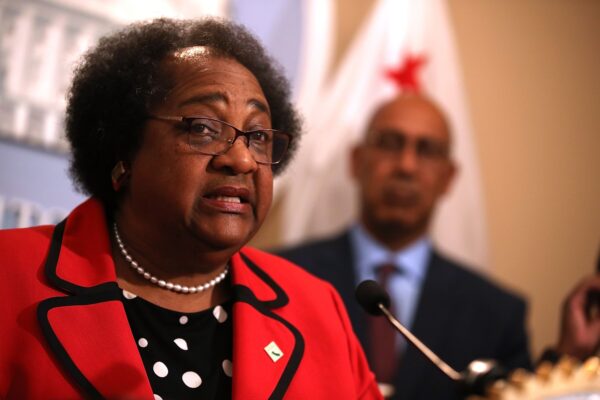By Karen Breslau
The numbers are striking in their precision. The statistical value of each year of human life, accounting for racial differences in life expectancy: $13,619. Wealth missing due to lower rates of Black home ownership: $148,099. Average devaluation of Black-owned businesses: $77,000. Each year of disproportionate incarceration factored by race, combining lost wages and freedom: $159,792.

These calculations by California’s Task Force to Study and Develop Reparation Proposals for African Americans, buried in the nearly 500-page draft of a report that will go to the state legislature in late June, belie the complexity and raw emotion underlying the first state-level effort to provide compensation for the legacy of slavery and discrimination in the US. By even considering reparations for harms that have compounded for centuries, California is transforming what has been a largely theoretical concept into a detailed model that may be adopted elsewhere as others also attempt to reckon with the costs of historical injustices. And at a potential cost of up to $800 billion, this would be to date the largest — and one of the most complex — reparations efforts in history.
Commissioned in the aftermath of the murder of George Floyd in 2020, California’s reparations panel has spent two years analyzing the racial gaps in health, wealth, housing, education and employment that affect many of the state’s Black residents — about 2.25 million, or 5.7% of a diverse population of nearly 40 million with no racial majority. Their recommendations will be delivered to the legislature on June 29, and supportive lawmakers plan to propose bills enacting at least some of the measures by the end of the legislative session in 2024.
Some proposals are symbolic, such as an official apology from the state of California for the historic atrocities and harms suffered by Black people. Others are familiar: greater investments in schools, health care, housing, job training and businesses in Black communities; improving access to higher education; advancing voting rights; and reforms in policing and public safety that gained renewed support after Floyd’s murder by Minneapolis police officers.
But none of the recommendations by the task force are more charged than offering direct compensation to eligible Black residents who are descended from a person enslaved in the US. Depending on the harms claimed and how many years a potential recipient has lived in California, the loss calculations go as high as $1.2 million per person.
In attempting to put a price on historical wrongs, California is forcing answers to questions that can’t be derived with neat equations: Who will be compensated and for what? Who pays the bill? And how will it be settled?
California’s ‘Sin Bill’
As the most populous US state, California is setting a potential roadmap for reparations at the federal level, where legislation has been introduced in Congress in every session since 1989. The most recent bill, introduced in May by Missouri Democratic Representative Cori Bush, calls for reparations to Black Americans totaling $14 trillion. That is how much proponents say is needed to close the racial wealth gap, which leaves White families with roughly six times more wealth than Black ones — an indicator of the losses that descendants of people enslaved in the US have suffered.
The reparations task force applied that concept in its work, identifying discriminatory policies and practices dating back to California’s statehood in 1850 and attempting to trace their impacts to the present day.
The nine-member panel is made up of civil rights advocates, academics and lawmakers. They consulted economists, statisticians, assessors, archivists and historians. They studied monetary and non-monetary precedents, including Germany’s reparations to Israel after the Holocaust, South Africa’s Truth & Reconciliation Commission, Chile’s compensation to victims of the military dictatorship of Augusto Pinochet, Canada’s payments to survivors of residential schools where Indigenous children were tortured and died, and the September 11th Victims Compensation Fund.
The panel also looked at reparations by the US government for other historical wrongs: the formal apology and $20,000 payments authorized by Congress in 1988 to Japanese Americans who were forced into internment camps during World War II; and a $9 million settlement and lifetime health care for survivors of the US Public Health Service Syphilis Study at Tuskegee on Black men that lasted until 1972.
Read more: How Reparations for Black Americans Have Gained Steam
And task force members traveled around California holding public hearings that became raucous and tearful, listening to testimony on Black-owned homes, businesses and farms seized by eminent domain or devalued through redlining and discriminatory lending practices. They heard stories of lives shattered by violence and incarceration, of Black neighborhoods where poverty, substandard schools and poor health have limited human potential for generations.
At 82, Reverend Amos C. Brown, vice chair of the reparations task force, is old enough to have had a great-great-grandfather who was enslaved. Born in Jackson, Mississippi, in 1941, he remembers vividly seeing photos of Emmett Till’s battered body after being murdered by white vigilantes in 1955. “He was the same age I was,” said Brown. “That shook me.”
Brown, who is also the pastor of San Francisco’s oldest Black congregation, sees reparations as California finally coming to terms with its “sin bill” for accumulated effects of slavery. Even though California outlawed slavery when it became a state in 1850, Black residents encountered discriminatory treatment since its founding, through the Gold Rush to the present day, in housing, health, employment, education and economic opportunity.
“You cannot put a dollar sign on racism, but our sin bill is so high it’s astronomical,” said Brown. “We are people of conscience and reason and goodwill. We’re not saying ‘pay it all at once,’ but you ought to do what you’ve done for others.”
A Down Payment on Injustice
It will be up to the state legislature to enact some or all of the recommendations from the task force — and to figure how to fund them. One concept under consideration is for the legislature to authorize a to-be-determined “down payment,” with the balance to be paid over time, through a combination of investments in Black communities and individual restitution for residents who can document harms based on government action.
State Senator Steven Bradford, one of two lawmakers on the task force, has proposed diverting 0.5% of the state’s $300 billion annual budget in order to generate a $1.5 billion annuity to fund reparations programs and payments over time. “If we are committed to it we can afford it,” he said.
But even in heavily Democratic California, public support for reparations is still lacking. While 71% of Californians say that racial and ethnic discrimination contributes to economic inequality in the US either a great deal or a fair amount, and 59% would approve of an official apology from the state for its role in perpetuating discrimination, only 43% of adults surveyed say they favor the state having a reparations task force, according to a new survey from the Public Policy Institute of California. Governor Gavin Newsom, a Democrat who championed the creation of the task force, seemed to acknowledge the political limitations in a recent statement: “Dealing with that legacy is about much more than cash payments.”
Estimates for the total cost of reparations, according to task force calculations, run as high as $800 billion — nearly three times the state budget. As California slides from an era of hefty surpluses into what is projected to be a $32 billion deficit in the coming fiscal year, Newsom has called on lawmakers to be “prudent” and brace for recession.
“There is no way we can afford $800 billion,” said James Gallagher, the Republican leader in the Assembly. “Who is going to pay that? Taxpayers? New immigrants? It would be grossly unfair in addition to being unfeasible.”
California Secretary of State Shirley Weber and other advocates say the state’s fiscal woes are not an excuse for inaction. As a legislator in 2020, she wrote the bill creating the reparations task force.
“When people say ‘we can’t spend that much money,’ I would say ‘What if what happened to African Americans happened to you? How much would it cost to make you whole?’” said Weber. “I doubt if anybody would say ‘Nothing, I’m happy being at the bottom of the rung and that everything’s OK.’”
Weber says she reminds people who question why they should bear liability for racial disparities that started generations ago that they “may not have planted the tree, but you surely enjoy the shade.”
That idea resonates far beyond California. In the UK, a group of aristocrats who inherited family wealth from the British slave trade have created an organization, Heirs of Slavery, to make voluntary reparations for the profits reaped by their ancestors and invited King Charles III to join.
In the US, building public support for reparations calls for a different conversation, one focused on return on investment rather than who pays what to whom, says Assembly member Reginald Jones-Sawyer Sr., the other elected official serving on the task force.
“Homeownership for African Americans may actually be a way to bring in more taxes, making schools equal in the inner cities for African American kids who are performing at a lower level, ending mass incarceration and plowing that money into recidivism programs and closing prisons,” he said in an interview. “What if we did an analysis on what that is to make more people able to live the American Dream, that it’s a cost benefit for all of us? Billions and billions of dollars is really billions of savings.”
A New Legacy
When it comes to reparations, there are still more questions than answers.
How can any government apportion liability on its citizens and taxpayers for harms that originated lifetimes ago, even if their impacts continue today? Should immigrants, of which there are many in California, assume the collective debt of reparations, even if they too are relatively poor and disadvantaged? Should eligibility be limited to descendants of people who were enslaved, or would the family members of a Black World War II veteran excluded from GI bill benefits also qualify, even if they arrived in the US long after slavery ended? What additional justice is owed descendants of indigenous and Chinese laborers, who suffered terrible deprivations in building California’s economy?
By focusing on the legacy of slavery and direct payments for its continuing impacts, the reparations movement is missing more effective approaches to closing the racial wealth gap, according to Richard Rothstein, author of “The Color of Law,” which chronicles US segregation in the 20th century.
In a new book, “Just Action,” co-authored with his daughter Leah, Rothstein advocates for remedies including subsidies for African Americans to buy homes in neighborhoods from which they were excluded and credit score reform to include rent paid on time, benefiting African Americans, who are more likely to rent than White Americans.
“African Americans as a race were excluded from many neighborhoods in this country by public policy and the consequences for their descendants are enormous,” Rothstein said. “If there was unconstitutional public policy, then race-conscious remedies would be justifiable.”
Some opponents of reparations in California concede investments are needed to improve education, housing and economic opportunity in Black communities, although they differ on the methods. “On some of the recommendations to increase home ownership I could see bipartisan support,” said Republican leader Gallagher. “We should do it in ways that benefit all Californians.”
Even if the state legislature does not enact cash payments anytime soon — or ever — the US reparations movement will likely be changed by California’s progress in driving a difficult public conversation and delivering a blueprint for restorative justice.
Jones-Sawyer, known as Reggie, knows well the power of example. On his phone, he pulls up a black-and-white photo of his uncle, Jefferson Thomas, one of the Little Rock Nine who integrated the Central High School in Little Rock, Arkansas, in 1957. The teenager stands in profile, eyes straight ahead, jaw clenched, near a bus stop, surrounded by jeering White students. Someone has urinated on him; others have thrown garbage.
Jones-Sawyer learned from his family the backstory of that very image, which is now used in histories of the Civil Rights Movement. On that day, there had been confusion about who was supposed to pick up Thomas from school, and while the 10th grader was left waiting, a crowd of White students gathered, preparing to attack. A boy he did not know came out of the crowd and told the others to knock it off.
“The next day, my uncle tried to thank the kid and started talking about him being sent by God,” said Jones-Sawyer. “But the kid said, ‘I’m an atheist, I just said something because it was the right thing to do.’”
As an elected official, Jones-Sawyer says he hopes reparations will become part of his own legacy. “I wish I could do what those nine kids did and give back to the people of California.”
–With assistance from Kelsey Butler, Denise Lu, Yue Qiu and Kyle Kim.
More stories like this are available on bloomberg.com.




